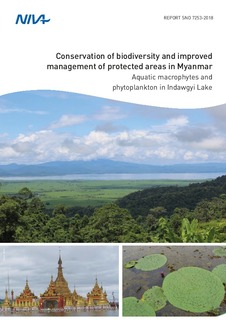| dc.contributor.author | Mjelde, Marit | |
| dc.contributor.author | Ballot, Andreas | |
| dc.contributor.author | Swe, Thida | |
| dc.date.accessioned | 2019-03-05T08:11:45Z | |
| dc.date.available | 2019-03-05T08:11:45Z | |
| dc.date.created | 2019-03-04T10:07:07Z | |
| dc.date.issued | 2018 | |
| dc.identifier.isbn | 978-82-577-6988-8 | |
| dc.identifier.issn | 1894-7948 | |
| dc.identifier.uri | http://hdl.handle.net/11250/2588635 | |
| dc.description | Project manager Marit Mjelde | nb_NO |
| dc.description.abstract | The aim of the study has been to give important and improved knowledge about aquatic macrophytes and phytoplankton biodiversity in the Indawgyi Lake. The survey took place in September 2017 and included physical measurements, water chemistry, phytoplankton, and aquatic macrophytes. Indawgyi Lake is the largest natural lake in Myanmar. The lake is a moderate alkaline and clear lake, with periodically very low oxygen levels. However, nutrient levels were low, most likely because of dilution due to integrated samples. The most important phytoplankton group was the cyanobacteria, dominated by Microcystis ichthyoblabe and M. viridis, which are known producers of hepatotoxic microcystins. One of the other present cyanobacterial species, Chrysosporum ovalisporum, is a potential producer of the hepatotoxic cyanotoxin cylindrospermopsin and is an invading species. Although the lake gave optically the impression of a eutrophic lake, the phytoplankton biomasses were relatively low. In total, 22 species of aquatic macrophytes were recorded, with the free-floating species Eichornia crassipes and nSalvinia cucellata as the most frequent species. They made large stands in most areas. Also, the submerged species Ceratophyllum demersum and Vallisneria spiralis were recorded in most areas. Eichornia crassipes was the only invasive species found in the lake. The most spectacular species in the lake is the very large floating-leaved species Euryale ferox. Based on preliminary indices, the ecological status of phytoplankton and aquatic macrophytes are classified as poor. However, to get a better understanding of the conditions in Indawgyi Lake and track the sources of pollution, a more extended survey is needed. To get a more complete overview of the aquatic biodiversity in Indawgyi Lake, we suggest visiting the lake again, preferably early in the dry season. | nb_NO |
| dc.description.sponsorship | Norwegian Environment Agency (NEA) | nb_NO |
| dc.language.iso | eng | nb_NO |
| dc.publisher | Norwegian institute for water research | nb_NO |
| dc.relation.ispartof | NIVA-rapport | |
| dc.relation.ispartofseries | NIVA-rapport;7253 | |
| dc.rights | Navngivelse-Ikkekommersiell-DelPåSammeVilkår 4.0 Internasjonal | * |
| dc.rights.uri | http://creativecommons.org/licenses/by-nc-sa/4.0/deed.no | * |
| dc.subject | Vannkjemi | nb_NO |
| dc.subject | Water chemistry | nb_NO |
| dc.subject | Ramsar område | nb_NO |
| dc.subject | Ramsar area | nb_NO |
| dc.subject | Feltregistreringer | nb_NO |
| dc.subject | Field survey | nb_NO |
| dc.subject | Biodiversitet i ferskvann | nb_NO |
| dc.subject | Freshwater biodiversity | nb_NO |
| dc.title | Conservation of biodiversity and improved management of protected areas in Myanmar. Aquatic macrophytes and phytoplankton in Indawgyi Lake | nb_NO |
| dc.type | Research report | nb_NO |
| dc.description.version | publishedVersion | nb_NO |
| dc.rights.holder | Norwegian institute for water research | nb_NO |
| dc.subject.nsi | VDP::Matematikk og naturvitenskap: 400 | nb_NO |
| dc.subject.nsi | VDP::Mathematics and natural scienses: 400 | nb_NO |
| dc.source.pagenumber | 41 | nb_NO |
| dc.source.issue | 7253 | nb_NO |
| dc.identifier.cristin | 1682028 | |
| dc.relation.project | Norsk institutt for vannforskning: 14346 | nb_NO |
| cristin.unitcode | 7464,30,19,0 | |
| cristin.unitname | Ferskvannsøkologi | |
| cristin.ispublished | true | |
| cristin.fulltext | original | |

